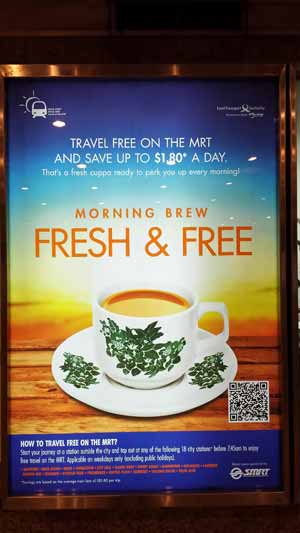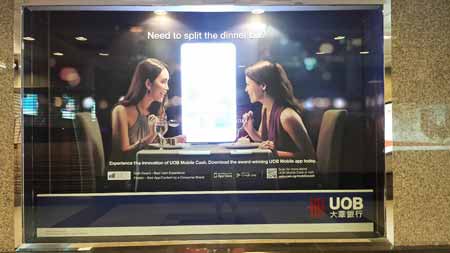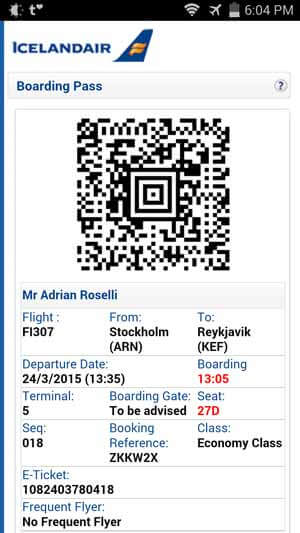QR Codes Work, Just Not in the U.S.
 You could say I am a bit of a fan of the potential of the lowly QR code. Mostly because the idea has merit, even though the implementations are generally terrible.
You could say I am a bit of a fan of the potential of the lowly QR code. Mostly because the idea has merit, even though the implementations are generally terrible.
I qualify that statement by limiting it to the United States. Outside of the U.S. they enjoy greater appeal to users and therefore to marketers. Christina Xu provides a couple reasons why QR codes are so popular across Southeast Asia:
1. For most Chinese people, the typical URL for a Chinese site is only slightly more human-readable than a QR code.
[…]
2. The install base for QR code scanning capabilities is simply way larger.
During my own travels in parts of Asia I have seen QR codes gracing nearly every conceivable surface. Most recently I snapped images of QR codes while in Singapore, a country where English is one of the official languages and where the advertisements and URLs embedded in the QR codes were also in English. The value of encoding complex URLs and allowing immediate action is apparent no matter the language.





I included the following context for the photos after days of seeing QR codes everywhere I went.
Dear Americans who doubt that QR codes get use in SE Asia. I snapped these five examples just walking out of MRT this morning, confirming my experience in Hong Kong, Kuala Lumpur, Singapore on multiple trips to each over five years
What We’ve Done Wrong in the U.S.
The fact that smart phones don’t come with a QR code reader pre-installed (nor prominently displayed or integrated if they are) has doomed QR uptake from the start. Too often I’ve seen people take a photo of a QR code while expecting something to happen, then deciding it’s not worth ever trying again. The sense of embarrassment or frustration doesn’t help motivate them to try again.
Beyond the difficulty for users to scan them, when we hear about failures in QR codes it’s often not the QR code itself, but the ongoing failure of brands (or their marketing teams) to understand the concept of link rot and link shorteners.
A recent example is Heinz Ketchup letting a domain registration lapse that had been used in a QR marketing campaign — right on its own bottle. When a user stumbled across the QR code that used this lapsed domain, he was taken to a porn site. This should not surprise anyone with any web savvy, let alone a marketing team (even AdWeek recognizes the issue is about the domain name lapsing, not the code itself).
I’ve previously written about QR codes that take users to mobile-unfriendly sites. That was 2011 and thankfully more and more sites are at least becoming responsive by default, but on the whole this is still an issue. That’s not the fault of QR codes, but people who never test them. Many examples abound on the web (though WTF QR CODES is probably the best known) and these have tainted the QR code.

Interestingly, the QR code has gained some traction in the U.S. in the reverse use. Many services will allow you to present a QR code on the screen of your smart phone to speed your airline boarding or to make a payment. The problem is that as consumers watch airline desk attendants and cashiers struggle to scan them properly, it doesn’t exactly raise the perception of the lowly QR code.
In the end the QR code was probably never going to last terribly long as a bridging technology, but in the U.S. they’ve been mis-used to the point that no one trusts them to provide a useful experience. That says a lot more about our own failures at usability in the blended industries of tech and marketing.
Related
I’ve written about QR codes before, partly because I think they had some great potential. Paired with smart implementations they could have been a boon to bridging meat space and the digital world for the short term. Oh well.
- Real World Hyperlinks, March 9, 2010
- Bar Codes as Web Portals, March 10, 2010
- Making and Using QR Codes, March 29, 2011
- Find QR Code Mistakes Before Making Your Own, June 30, 2011
- Calling QR in Print CSS Only When Needed, March 8, 2013
Update: September 16, 2015
Beacons, QR Codes and 3-D Printing: Enter The Museum of the 21st Century, which seems to suggest the wrong century thanks to its QR reference, talks a bit about using technology in the modern museum. QR codes are used as a method to provide visitors with more information, which can be updated more easily, and also to track what information is most requested. To satisfy my ego, I should note that this is a model I pitched to a museum in 2009. The museum didn’t bite.
Update: September 22, 2015
Cennydd Bowles provides a pretty straightforward answer to the question, Should I use a QR code?
Should I use a QR code? pic.twitter.com/wl6TJg9w6N
In case the embedded image is lost or you cannot read it, here’s the transcript:
- Should I use a QR code?
- Well, perhaps. QR codes may not be ideal as calls-to-action in printed marketing, but they have a range of applications from the logistics to air travel. They’re particularly popular in emerging and Eastern consumer markets too. As always, the key is to understand your business and user needs and choose the appropriate technology.
- Makes sense. Thanks!
- My pleasure!
Update: December 14, 2015
@MichaelCarusi @StartupLJackson Yeah, you really need to learn a bit more about cultures outside the US: adrianroselli.com/2015/07/qr-codes-work-just-not-in-the-u-s.html
Update: August 10, 2022
While an opinion writer at The Washington Post has asserted QR code menus are the death of civilization, at least one reader has point out that instead of being discriminatory they can be quite enabling:
As a blind person QR code menus have made my life 1000% easier. Please, please keep them as an accessibility option even if you return to having paper menus. I can actually read menus now. twitter.com/Aerohaveno/status/15564
Meanwhile, not even two months after the WaPo piece, TetraLogical shared its own post on Accessibility and QR codes. Generally it covers potential benefits and risks.
A couple years ago I had the pleasure of testing a QR code reader feature built into an app for a financial sector client, specifically with blind users. It tested well.
I have seen folks critical of QR codes for blind users more than once, which suggests they have had little experience with QR codes, blind users, or recognizing accessibility affordances.
3 Comments
It is very sad to see a technology as accessible and functional as the QR Code being abandoned mainly by Apple. I can not understand why Google does not use QR code to set up the YouTube user account on TV.
do you know how many smartphone users use or scann currently a QR code in the USA?
In response to . Saul, I do not. I would like to think some savvy marketers have data on this already. At the very least, you can test with your own audience by including a query string in the URL you encode so you can track use.
Leave a Reply to Luiz Siqueira Neto Cancel response